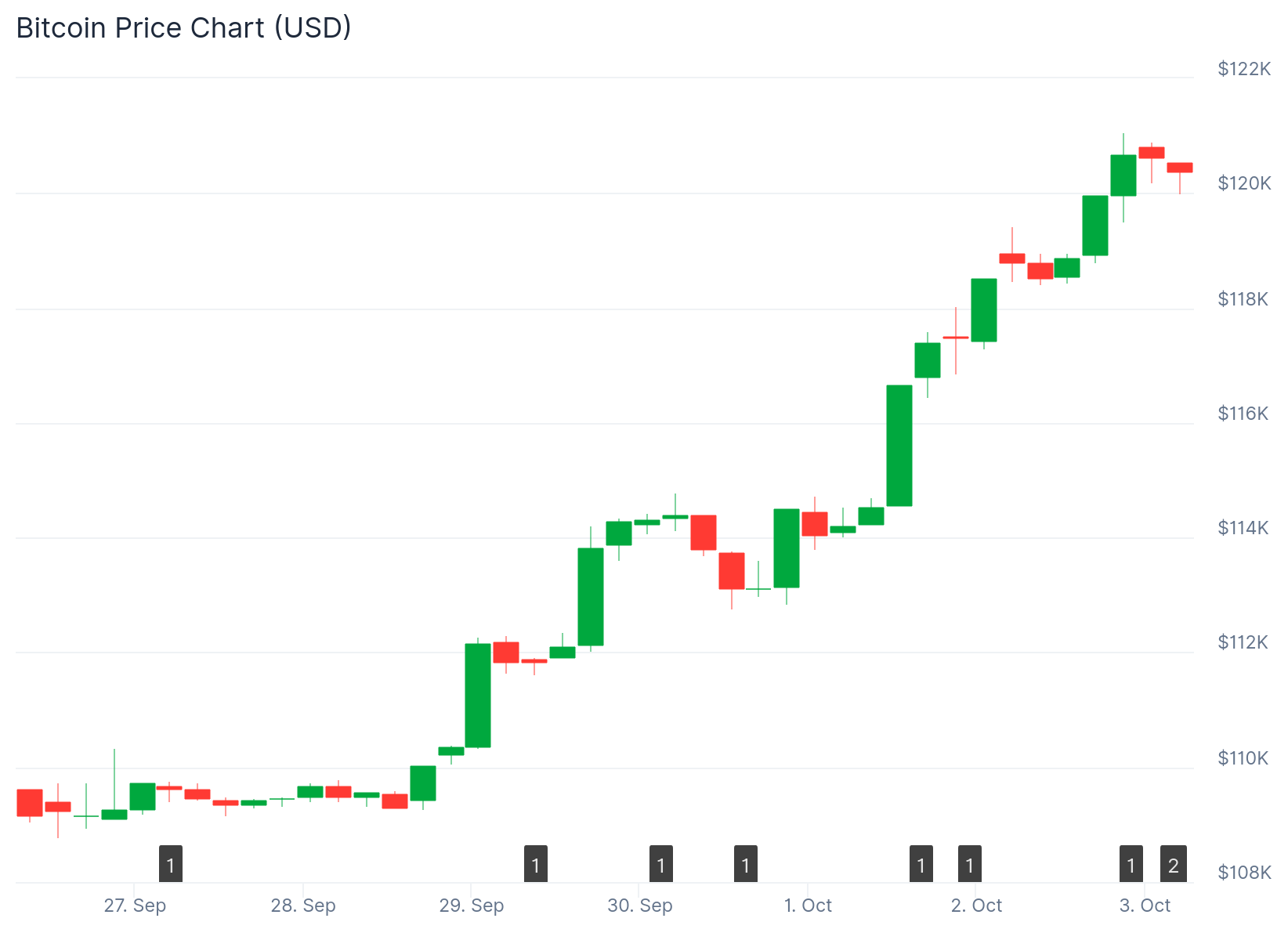TLDR
- Bitcoin price hit $121,000 on Thursday, marking its highest level in seven weeks
- More than $313 million in short positions were liquidated, creating a short squeeze effect
- Gold reached a new all-time high above $3,900, supporting alternative asset demand
- Federal Reserve rate cut probability stands at 98% for October meeting
- Bitcoin and Ethereum ETFs saw combined inflows of $2.4 billion this week
Bitcoin price reached $121,000 on Thursday, climbing to its highest point since mid-August. The cryptocurrency has recovered most of its losses since touching an all-time high of approximately $124,000 on August 14.

The rally caught bearish traders off guard. CoinGlass data shows over $313 million in leveraged short positions were liquidated between Wednesday and Thursday. These forced liquidations often trigger additional buying pressure, pushing prices higher.
Market analysts note current conditions appear more favorable than during Bitcoin’s mid-August peak. Multiple factors are now aligning to support continued upward momentum.
Gold Rally Supports Bitcoin Gains
Gold prices hit a fresh all-time high above $3,900 on Thursday after rallying 16% over six weeks. Central banks have been steadily accumulating the precious metal, according to World Gold Council data.
JPMorgan analysts say Bitcoin appears undervalued compared to gold on a volatility-adjusted basis. Their analysis suggests Bitcoin could reach $165,000 by year-end based on this metric.
The gold rally reflects growing demand for alternative assets as investors seek hedges against inflation and currency debasement. This trend is benefiting Bitcoin alongside traditional safe-haven assets.
Retail investors have been driving what analysts call the “debasement trade,” allocating funds to both gold and Bitcoin. This marks a shift from purely speculative positioning to longer-term strategic holdings.
Federal Reserve Rate Cut Expectations Build
The US Personal Consumption Expenditures Price Index showed a 2.9% increase from August, matching analyst forecasts. The inflation data reinforced expectations that the Federal Reserve will continue cutting interest rates.
CME FedWatch tool data shows a 98% probability of another quarter-point rate cut at the October Federal Reserve meeting. The central bank cut rates in September for the first time in four years.
The implied probability of rates falling to 3.50% or below by January 2026 now stands at 40%. This compares to just 18% probability in mid-August.
Federal Reserve Vice Chair Philip Jefferson expressed concerns about labor market stress on Monday. He attributed potential pressure to trade and immigration policies, noting effects “will further show in coming months.”
Lower interest rates typically benefit risk assets like Bitcoin by reducing the opportunity cost of holding non-yielding investments.
Strong ETF Demand and October Seasonality
Bitcoin and Ethereum ETFs recorded combined inflows of nearly $2.4 billion this week. The strong institutional demand comes as both cryptocurrencies extend October gains.
October has historically been Bitcoin’s best-performing month. The cryptocurrency has averaged gains exceeding 14% during October since 2013, earning the month the nickname “Uptober.”
Ethereum climbed above $4,500 this week, reaching its strongest level in three weeks. The second-largest cryptocurrency is benefiting from improved overall market sentiment.
The US government shutdown that began October 1 has not deterred the crypto rally. Historical data shows the S&P 500 has gained during every government shutdown since 1990. Bitcoin is tracking stock market movements more closely in 2025.
Crypto-related stocks are participating in the rally. Coinbase shares rose over 7%, while Bullish and Circle gained 11% and 16% respectively.
Bitcoin derivatives data from Deribit shows put options trading at a premium to call options, indicating moderate caution among traders. This represents less aggressive positioning compared to mid-August when Bitcoin last approached current price levels.
OpenAI’s $500 billion valuation in a recent share sale helped ease concerns about the AI sector following export restrictions and hiring freezes at major tech companies.
John Haar from Swan Bitcoin noted the market is shifting from speculative trades to strategic allocations as Bitcoin increasingly functions as a non-sovereign reserve asset.



